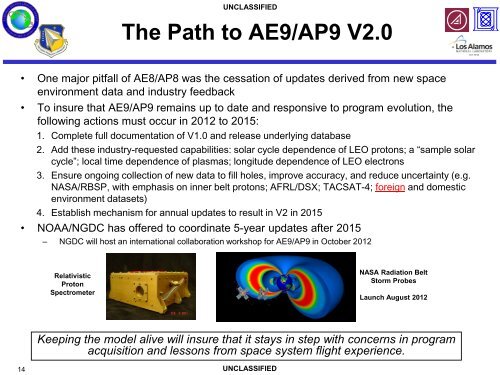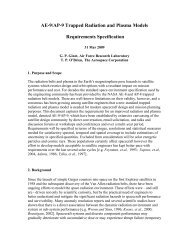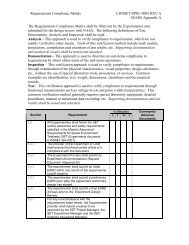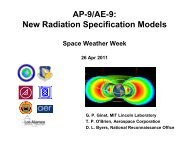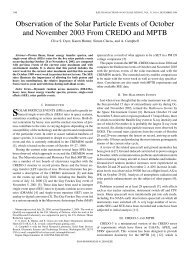The AE9/AP9 Next Generation Radiation Specification ... - SET - NASA
The AE9/AP9 Next Generation Radiation Specification ... - SET - NASA
The AE9/AP9 Next Generation Radiation Specification ... - SET - NASA
Create successful ePaper yourself
Turn your PDF publications into a flip-book with our unique Google optimized e-Paper software.
UNCLASSIFIED<strong>The</strong> Path to <strong>AE9</strong>/<strong>AP9</strong> V2.0• One major pitfall of AE8/AP8 was the cessation of updates derived from new spaceenvironment data and industry feedback• To insure that <strong>AE9</strong>/<strong>AP9</strong> remains up to date and responsive to program evolution, thefollowing actions must occur in 2012 to 2015:1. Complete full documentation of V1.0 and release underlying database2. Add these industry-requested capabilities: solar cycle dependence of LEO protons; a “sample solarcycle”; local time dependence of plasmas; longitude dependence of LEO electrons3. Ensure ongoing collection of new data to fill holes, improve accuracy, and reduce uncertainty (e.g.<strong>NASA</strong>/RBSP, with emphasis on inner belt protons; AFRL/DSX; TACSAT-4; foreign and domesticenvironment datasets)4. Establish mechanism for annual updates to result in V2 in 2015• NOAA/NGDC has offered to coordinate 5-year updates after 2015– NGDC will host an international collaboration workshop for <strong>AE9</strong>/<strong>AP9</strong> in October 2012RelativisticProtonSpectrometer<strong>NASA</strong> <strong>Radiation</strong> BeltStorm ProbesLaunch August 2012Keeping the model alive will insure that it stays in step with concerns in programacquisition and lessons from space system flight experience.14UNCLASSIFIED


